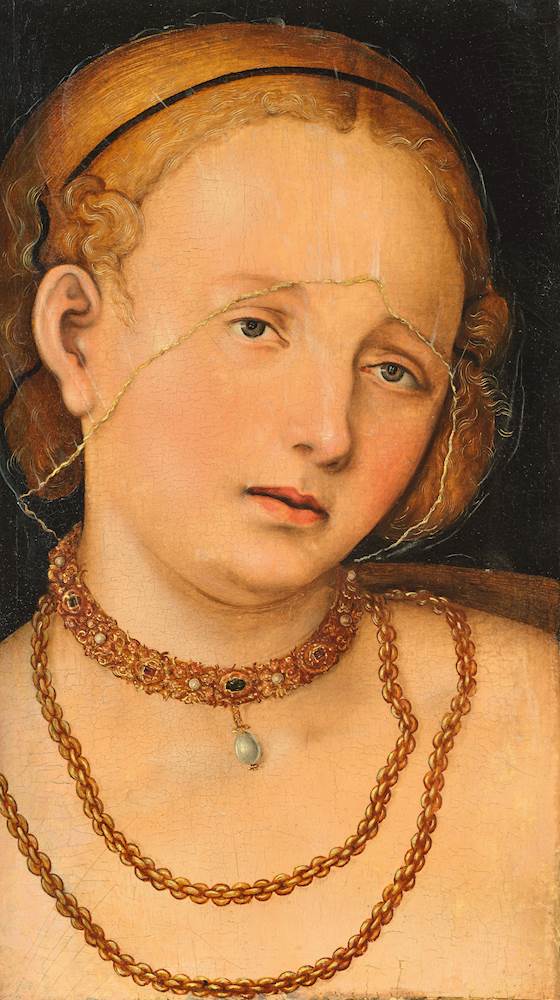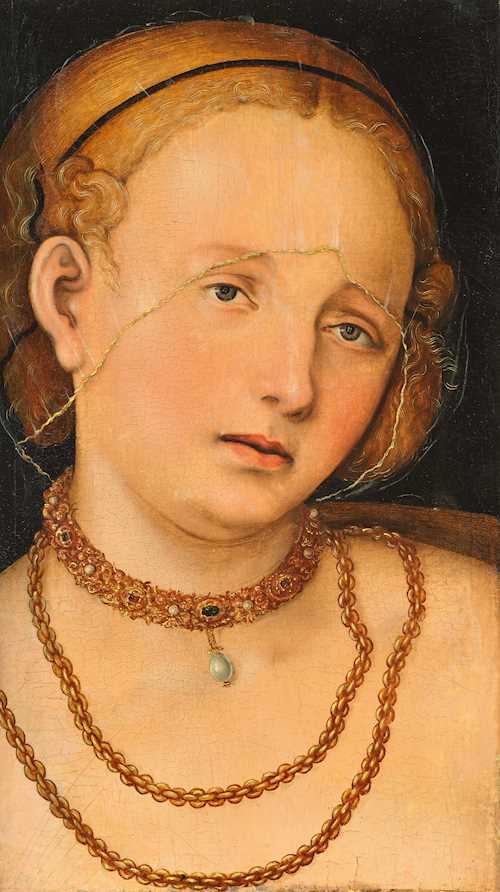
Lot 3016* - A210 Tableaux de Maîtres Anciens - vendredi, 20. septembre 2024, 14h00
LUCAS CRANACH the Elder
(Kronach 1472–1553 Weimar)
Lucretia. Circa 1535–45.
Oil on panel.
36.6 × 20.4 cm.
Provenance:
- French-Belgian private collection since the 1970s.
- European private collection.
Lucretia, a Roman heroine from the 6th century BC who was famous for her beauty and virtue, chose suicide after being raped by Sextus Tarquin. This sensual and erotic figure, considered the embodiment of virtue, chastity and honour, is closely associated with the work of the German painter Lucas Cranach the Elder. Several versions of this subject were created by Cranach and his workshop. The present painting was likely once part of a larger work that depicted Lucretia, probably half life-size, with a dagger. The young woman's melancholy gaze shows her resignation in the face of her fate, a typical element of this subject.
Lucas Cranach the Elder maintained a workshop in which his son Lucas the Younger (1515–1586) and other employees worked. Both material and stylistic elements indicate that the work offered here was created in his workshop. On the one hand, it is painted on beech wood, a material which was generally rarely used for painting supports at the time, but which was frequently used in Cranach’s workshop, as Professor Gunnar Heydenreich has been able to prove (see Gunnar Heydenreich: Lucas Cranach the Elder. Painting materials, techniques and workshop practice, Amsterdam 2007, pp. 48–50). The gold used as a pigment on the veil also corresponds to a material used in Cranach’s workshop and emphasises the particular luxuriousness of this work.
Prof Gunnar Heydenreich places this work in the vicinity of the Lucretia in the Museo de Bellas Artes in Bilbao (inv. no. 12/79, oil on panel, 50.5 × 36.2 cm), painted in the early 1530s. There, too, Lucretia is depicted against a dark background, her head tilted to the right and wearing comparable jewellery and an almost transparent veil. The same veil over the heroine’s hair can also be seen in a Lucretia from 1535 in the Niedersächsisches Landesmuseum in Hanover (see Gert van der Osten: Katalog der Gemälde Alter Meister in der Niedersächsischen Landesgalerie Hannover, Hanover 1954, inv. no. 59, oil on panel, 51.7 × 34.8 cm). The same physiognomic and expressive features can be found in these comparative works as in our painting.
The present painting is characterised by a high quality of execution and numerous extremely finely worked details, particularly in the depiction of the skin tones and hair as well as in the fine depiction of the white pearl. While these elements testify to great skill and attention to detail, other parts of the work possibly indicate the involvement of his son, Lucas Cranach the Younger, who worked in his father's workshop.
After examining the original, Prof Gunnar Heydenreich has confirmed that the present work is a high-quality depiction of Lucretia created in the workshop of Lucas Cranach the Elder in the years 1535–45, whereby a partial involvement of Lucas Cranach the Elder cannot be ruled out.
After examining the original, Dr Dieter Koepplin has also confirmed that it was made either by Lucas Cranach the Elder or his son Lucas Cranach the Younger and emphasises the particularly high quality of the execution. He assumes that it was painted around 1538-41 and points in particular to stylistic parallels with the Lucretia in the National Museum in Warsaw, which is dated 1538 (inv. no. Wil 1749, oil on panel, 59 × 40 cm; see Max J. Friedländer and Jakob Rosenberg: Die Gemälde von Lucas Cranach, Basel/Boston/Stuttgart 1979, p. 150, cat. no. 397).
Lucas Cranach the Elder maintained a workshop in which his son Lucas the Younger (1515–1586) and other employees worked. Both material and stylistic elements indicate that the work offered here was created in his workshop. On the one hand, it is painted on beech wood, a material which was generally rarely used for painting supports at the time, but which was frequently used in Cranach’s workshop, as Professor Gunnar Heydenreich has been able to prove (see Gunnar Heydenreich: Lucas Cranach the Elder. Painting materials, techniques and workshop practice, Amsterdam 2007, pp. 48–50). The gold used as a pigment on the veil also corresponds to a material used in Cranach’s workshop and emphasises the particular luxuriousness of this work.
Prof Gunnar Heydenreich places this work in the vicinity of the Lucretia in the Museo de Bellas Artes in Bilbao (inv. no. 12/79, oil on panel, 50.5 × 36.2 cm), painted in the early 1530s. There, too, Lucretia is depicted against a dark background, her head tilted to the right and wearing comparable jewellery and an almost transparent veil. The same veil over the heroine’s hair can also be seen in a Lucretia from 1535 in the Niedersächsisches Landesmuseum in Hanover (see Gert van der Osten: Katalog der Gemälde Alter Meister in der Niedersächsischen Landesgalerie Hannover, Hanover 1954, inv. no. 59, oil on panel, 51.7 × 34.8 cm). The same physiognomic and expressive features can be found in these comparative works as in our painting.
The present painting is characterised by a high quality of execution and numerous extremely finely worked details, particularly in the depiction of the skin tones and hair as well as in the fine depiction of the white pearl. While these elements testify to great skill and attention to detail, other parts of the work possibly indicate the involvement of his son, Lucas Cranach the Younger, who worked in his father's workshop.
After examining the original, Prof Gunnar Heydenreich has confirmed that the present work is a high-quality depiction of Lucretia created in the workshop of Lucas Cranach the Elder in the years 1535–45, whereby a partial involvement of Lucas Cranach the Elder cannot be ruled out.
After examining the original, Dr Dieter Koepplin has also confirmed that it was made either by Lucas Cranach the Elder or his son Lucas Cranach the Younger and emphasises the particularly high quality of the execution. He assumes that it was painted around 1538-41 and points in particular to stylistic parallels with the Lucretia in the National Museum in Warsaw, which is dated 1538 (inv. no. Wil 1749, oil on panel, 59 × 40 cm; see Max J. Friedländer and Jakob Rosenberg: Die Gemälde von Lucas Cranach, Basel/Boston/Stuttgart 1979, p. 150, cat. no. 397).
CHF 70 000 / 120 000 | (€ 72 160 / 123 710)
Vendu pour CHF 260 000 (prix marteau)
Aucune responsabilité n'est prise quant à l´exactitude de ces informations.


